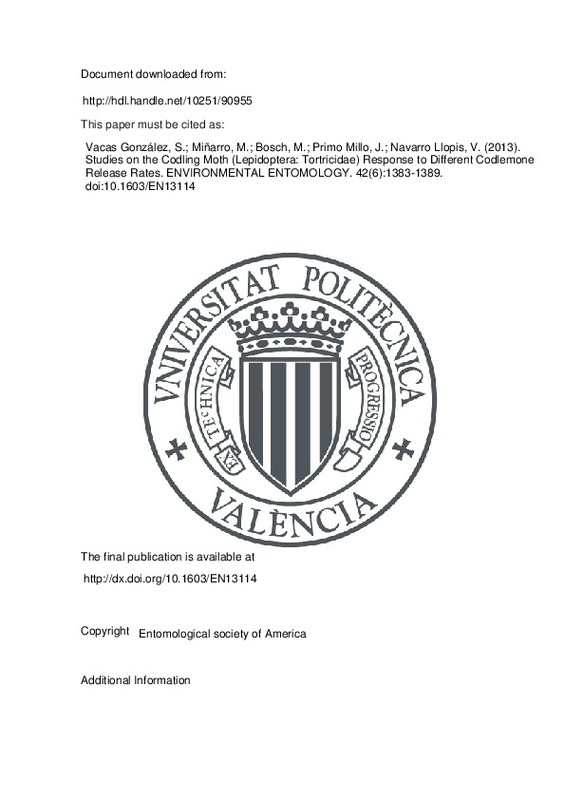JavaScript is disabled for your browser. Some features of this site may not work without it.
Buscar en RiuNet
Listar
Mi cuenta
Estadísticas
Ayuda RiuNet
Admin. UPV
Studies on the Codling Moth (Lepidoptera: Tortricidae) Response to Different Codlemone Release Rates
Mostrar el registro sencillo del ítem
Ficheros en el ítem
| dc.contributor.author | Vacas González, Sandra
|
es_ES |
| dc.contributor.author | Miñarro, M
|
es_ES |
| dc.contributor.author | Bosch, MD
|
es_ES |
| dc.contributor.author | Primo Millo, Jaime
|
es_ES |
| dc.contributor.author | Navarro Llopis, Vicente
|
es_ES |
| dc.date.accessioned | 2017-11-14T08:24:21Z | |
| dc.date.available | 2017-11-14T08:24:21Z | |
| dc.date.issued | 2013 | es_ES |
| dc.identifier.issn | 0046-225X | es_ES |
| dc.identifier.uri | http://hdl.handle.net/10251/90955 | |
| dc.description.abstract | [EN] The response of the codling moth (Cydia pomonella L. (Lepidoptera: Tortricidae)) to different emission values of its main pheromone component, 8E,10E-dodecadien-1-ol (codlemone), was investigated in three field trials conducted in plots without mating disruption treatments. Moth catches obtained in traps baited with pheromone dispensers were correlated with the corresponding codlemone release rates by multiple regression analysis. In a preliminary trial conducted in Lleida (NE Spain), a decreasing trend of captures was observed based on increasing pheromone levels. After this, the pheromone release profiles of the pheromone dispensers were studied, in parallel with the field trials, by residual codlemone extraction and gas chromatography quantification. In the trials carried out in Asturias (NW Spain), a correlation between trap catches and emission levels (within the range from 11 to 1,078 microg/d) was found and fitted a logarithmic model. Captures followed a decreasing linear trend in the range of emission rates from 11 to 134 microg/d. Given that release values comprised between 11 and 67 mcrog/d did not lead to significantly different catches in traps, this emission range could be considered to develop effective formulations for attraction purposes when mating disruption is not acting in the environment. | es_ES |
| dc.language | Inglés | es_ES |
| dc.publisher | Entomological society of America | es_ES |
| dc.relation.ispartof | ENVIRONMENTAL ENTOMOLOGY | es_ES |
| dc.rights | Reserva de todos los derechos | es_ES |
| dc.subject | Cydia pomonella | es_ES |
| dc.subject | Mating disruption | es_ES |
| dc.subject | Mesoporous dispenser | es_ES |
| dc.subject | Pheromone | es_ES |
| dc.subject | Release rate | es_ES |
| dc.subject.classification | QUIMICA ORGANICA | es_ES |
| dc.title | Studies on the Codling Moth (Lepidoptera: Tortricidae) Response to Different Codlemone Release Rates | es_ES |
| dc.type | Artículo | es_ES |
| dc.identifier.doi | 10.1603/EN13114 | es_ES |
| dc.rights.accessRights | Abierto | es_ES |
| dc.contributor.affiliation | Universitat Politècnica de València. Instituto Agroforestal Mediterráneo - Institut Agroforestal Mediterrani | es_ES |
| dc.contributor.affiliation | Universitat Politècnica de València. Departamento de Química - Departament de Química | es_ES |
| dc.description.bibliographicCitation | Vacas González, S.; Miñarro, M.; Bosch, M.; Primo Millo, J.; Navarro Llopis, V. (2013). Studies on the Codling Moth (Lepidoptera: Tortricidae) Response to Different Codlemone Release Rates. ENVIRONMENTAL ENTOMOLOGY. 42(6):1383-1389. doi:10.1603/EN13114 | es_ES |
| dc.description.accrualMethod | S | es_ES |
| dc.relation.publisherversion | http://dx.doi.org/10.1603/EN13114 | es_ES |
| dc.description.upvformatpinicio | 1383 | es_ES |
| dc.description.upvformatpfin | 1389 | es_ES |
| dc.type.version | info:eu-repo/semantics/publishedVersion | es_ES |
| dc.description.volume | 42 | es_ES |
| dc.description.issue | 6 | es_ES |
| dc.identifier.pmid | 24280412 | |
| dc.relation.pasarela | S\256880 | es_ES |







![[Cerrado]](/themes/UPV/images/candado.png)

